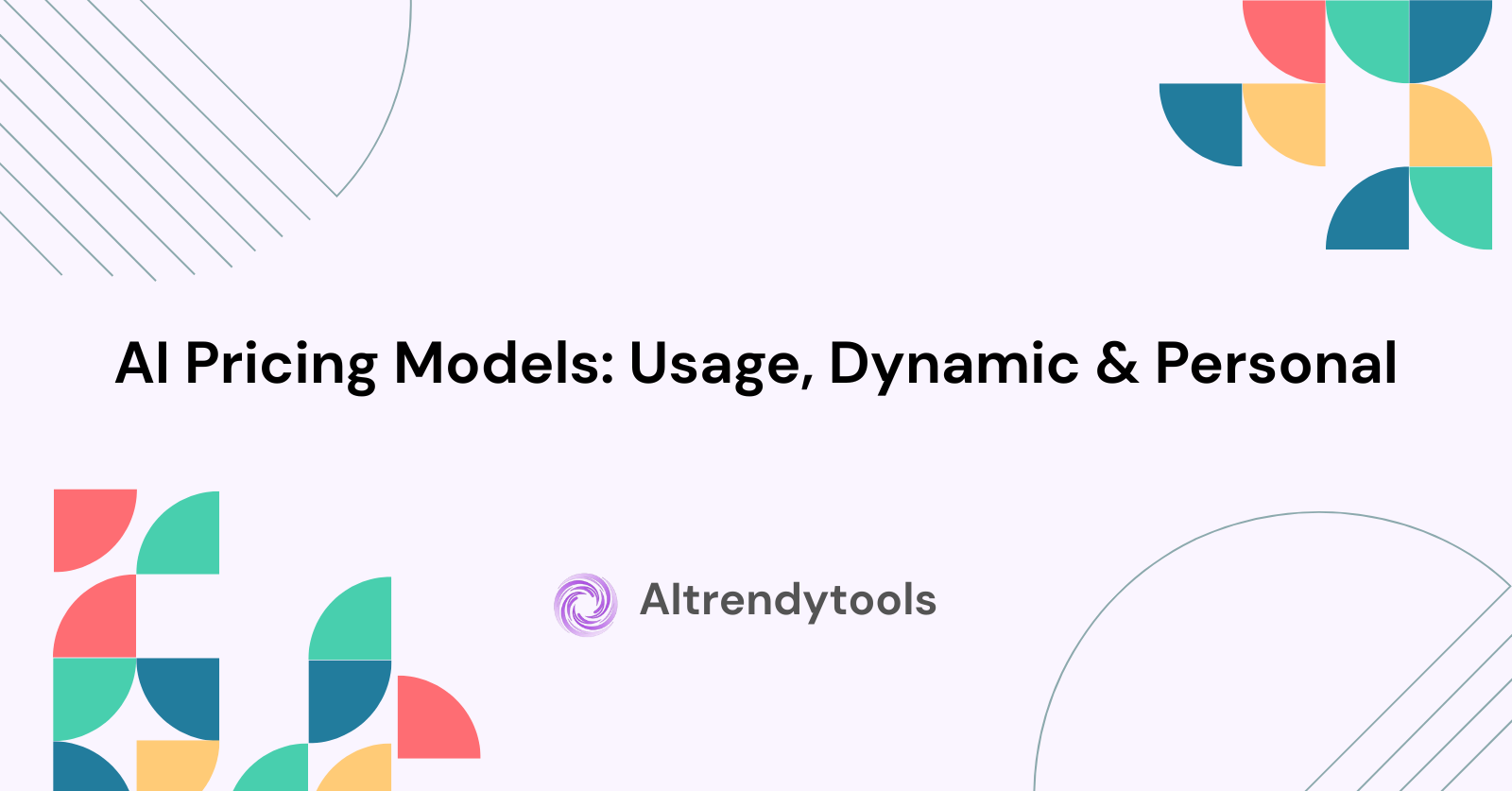🔥 AITrendytools: The Fastest-Growing AI Platform |
Write for us
Pricing strategies have evolved dramatically over the past decade. Artificial intelligence now powers sophisticated pricing systems that adapt to market conditions, customer behavior, and real-time demand. Businesses across industries are implementing AI pricing strategies to maximize revenue while maintaining competitive advantages.
Traditional static pricing models no longer meet the demands of modern markets. Companies need flexible approaches that respond instantly to changing conditions. Machine learning pricing enables organizations to analyze vast amounts of data and make informed decisions within milliseconds.
Understanding AI Pricing Strategies
Artificial intelligence transforms how businesses determine prices for their products and services. These systems process multiple data points including competitor pricing, inventory levels, customer demographics, and purchase history. The technology identifies patterns that humans might miss.
Machine learning algorithms continuously improve their accuracy over time. Each transaction provides new data that refines the pricing model. This self-improving capability makes AI pricing strategies increasingly effective as they mature.
Key benefits of automated pricing systems:
- Eliminates emotional decision-making from pricing processes
- Provides real-time adjustments based on market conditions
- Increases profit margins through data-driven optimization
- Reduces manual workload for pricing teams
- Captures maximum value from each transaction
Companies implementing these technologies report significant improvements in revenue generation. The systems base prices purely on data analysis rather than gut feelings or outdated spreadsheets.
Usage-Based Pricing Models
Pay-per-use models have gained tremendous popularity in the digital economy. Customers pay only for what they consume rather than fixed subscription fees. This approach aligns costs directly with value received.
Cloud computing services pioneered consumption-based pricing at scale. Businesses access computing resources and pay based on actual usage. Storage space, processing power, and bandwidth all factor into the final bill.
AI enhances usage-based models through precise metering and prediction. Smart pricing technology tracks consumption patterns and forecasts future needs. Customers receive personalized recommendations about optimal usage levels.
Benefits of Consumption-Based Pricing
The fairness inherent in pay-per-use models appeals to modern customers. Light users avoid subsidizing heavy users. This transparency builds trust and reduces friction in the buying process.
Advantages for businesses:
- Lower customer acquisition costs
- Reduced commitment barriers for new customers
- Revenue scales naturally with customer success
- Detailed insights into product usage patterns
- Data-driven product development decisions
Advantages for customers:
- Pay only for actual consumption
- No upfront commitments required
- Flexibility to scale up or down
- Clear understanding of costs
- Better budget control
Usage metering systems powered by AI provide detailed insights into customer behavior. Companies identify which features drive the most value. Business intelligence tools help product development teams use this data to prioritize improvements.
Implementing Pay-Per-Use Models Successfully
Accurate tracking systems form the foundation of effective usage-based pricing. AI monitors consumption in real-time without manual intervention. Billing becomes automated and error-free.
Implementation steps:
- Deploy accurate metering infrastructure
- Set up automated billing systems
- Create transparent pricing tiers
- Provide usage monitoring dashboards
- Implement predictive analytics tools
- Design flexible pricing structures
Clear communication about pricing tiers prevents customer confusion. Predictive pricing analytics help customers understand their likely costs. Businesses provide tools that allow customers to monitor and control spending.
Dynamic Pricing Optimization
Dynamic rate adjustment represents one of the most powerful applications of AI in pricing. Prices fluctuate based on supply, demand, competition, and numerous other factors. Airlines and hotels have used these models for decades.
Real-time pricing optimization now extends far beyond travel industries. E-commerce retailers adjust prices thousands of times daily. Ride-sharing services change rates based on driver availability and passenger demand.
Machine learning algorithms analyze historical data to identify optimal price points. The systems test different prices and measure customer response. Over time, they learn which prices maximize both sales volume and profit margins.
Factors Influencing Dynamic Prices
Demand-based pricing considers how badly customers want a product at any given moment. Concert tickets become more expensive as the event date approaches and availability decreases. Sports merchandise prices surge when teams enter playoffs.
Primary factors affecting dynamic prices:
- Current market demand levels
- Competitor pricing movements
- Inventory availability
- Time of day and seasonality
- Customer browsing behavior
- Geographic location
- Weather conditions
- Special events and holidays
Competitor pricing significantly influences dynamic pricing decisions. AI systems monitor rival prices across the internet. Automated adjustments maintain competitive positioning without constant human oversight.
Inventory levels play a crucial role in price determination. Products with excess stock might see price reductions to accelerate sales. Limited inventory items command premium prices to maximize revenue from scarce resources.
Real-Time Pricing in Action
Retailers use variable pricing algorithms to respond to market changes instantly. A competitor's price drop triggers automatic adjustments. The system balances competitiveness with profitability targets.
Industries using dynamic pricing:
- E-commerce and online retail
- Travel and hospitality
- Ride-sharing and transportation
- Event tickets and entertainment
- Energy and utilities
- Food delivery services
- Parking facilities
- Advertising platforms
Dynamic pricing works particularly well for perishable goods and services. Restaurant reservation platforms charge more for prime dining times. Food delivery services adjust prices based on restaurant capacity and driver availability.
The technology prevents revenue loss from outdated pricing. Manual price updates cannot match the speed and accuracy of automated systems. Businesses capture opportunities that would otherwise slip away.
Personal Pricing and Customer Segmentation
Pricing personalization tailors prices to individual customers based on their characteristics and behavior. This sophisticated approach maximizes willingness to pay while maintaining fairness perceptions. AI makes personal pricing possible at scale.
Customer-based pricing considers factors like purchase history, browsing behavior, location, and device type. Students might receive discounts while corporate buyers pay standard rates. Loyal customers gain access to special pricing tiers.
Data points used in personal pricing:
- Purchase history and frequency
- Average order value
- Customer lifetime value
- Geographic location
- Device type and browser
- Time spent on website
- Cart abandonment patterns
- Email engagement rates
- Social media interactions
Behavioral pricing analyzes how customers interact with a website or app. Someone who abandons a shopping cart might receive a discount offer. Frequent visitors see different prices than first-time guests.
Ethical Considerations in Personal Pricing
Pricing intelligence software must balance personalization with transparency. Customers react negatively when they discover others paid less for identical products. Businesses need clear policies about how they determine individual prices.
Ethical guidelines for personalization:
- Maintain price transparency standards
- Protect customer data privacy
- Avoid discriminatory pricing practices
- Comply with regional regulations
- Provide clear terms and conditions
- Allow customer opt-out options
- Regular audits of pricing algorithms
Data privacy concerns require careful handling of customer information. Companies must protect sensitive data used in pricing algorithms. Compliance with regulations like GDPR becomes essential.
Fair pricing practices build long-term customer relationships. While AI can identify maximum willingness to pay, exploiting this knowledge damages brand reputation. Smart businesses use personalization to create value rather than extract it.
Implementing Personalized Pricing Strategies
Data-driven pricing decisions require robust customer data collection. CRM systems integrate with pricing engines to provide comprehensive customer profiles. Purchase history, support interactions, and engagement metrics all contribute to pricing models.
Segmentation strategies group similar customers together. Each segment receives pricing appropriate to their characteristics and behaviors. B2B companies often personalize prices based on deal size and customer lifetime value.
Segmentation criteria:
- Demographics and firmographics
- Behavioral patterns
- Purchase frequency
- Product preferences
- Price sensitivity levels
- Customer loyalty status
Testing frameworks help refine personalized pricing approaches. A/B testing reveals which personalization strategies drive the best results. Machine learning models continuously optimize based on actual customer responses.
Combining Multiple AI Pricing Models
Modern businesses often implement hybrid approaches that blend different pricing strategies. A SaaS company might use usage-based billing with dynamic pricing adjustments. Personal pricing layers add another dimension of optimization.
Integration between pricing systems creates powerful synergies. Usage data informs dynamic pricing decisions. Customer segments receive personalized offers based on their consumption patterns.
Revenue optimization occurs when all pricing levers work together harmoniously. AI coordinates these complex interactions automatically. Human strategists set high-level goals while algorithms handle execution.
Building a Comprehensive Pricing Strategy
Successful implementation starts with clear business objectives. Companies must decide whether they prioritize market share, profit margins, or customer acquisition. Different goals require different pricing approaches.
Strategic development process:
- Define pricing objectives and goals
- Analyze current pricing effectiveness
- Select appropriate pricing models
- Design technology infrastructure
- Implement pilot programs
- Measure and optimize results
- Scale successful strategies
Technology infrastructure needs careful planning. Pricing engines must integrate with existing systems including inventory management, CRM, and e-commerce platforms. Data flows smoothly between all components.
Change management helps teams adapt to automated pricing systems. Sales teams need training on how AI pricing works. Customer service representatives must explain pricing models to customers.
Technology Behind AI Pricing Systems
Machine learning models form the core of modern pricing systems. Neural networks process vast datasets to identify patterns and relationships. Deep learning techniques handle particularly complex pricing scenarios.
Natural language processing analyzes customer reviews and social media sentiment. This qualitative data supplements quantitative metrics. AI understands how customers feel about current pricing.
Core technologies powering AI pricing:
- Machine learning algorithms
- Neural networks
- Predictive analytics
- Natural language processing
- Big data processing
- Real-time analytics
- Cloud computing infrastructure
- API integrations
Predictive analytics forecast future demand and market conditions. Businesses prepare for seasonal fluctuations and market trends. Inventory planning aligns with anticipated pricing changes.
Data Requirements for Effective AI Pricing
Historical transaction data provides the foundation for training pricing models. Years of sales records help AI understand patterns. The more data available, the more accurate the predictions become.
Essential data sources:
- Transaction history
- Customer demographics
- Product catalog information
- Competitor prices
- Market trends
- Economic indicators
- Website analytics
- Inventory levels
- Seasonal patterns
External data sources enrich internal datasets. Market research insights, economic indicators, and competitor information all contribute to better pricing decisions. Web scraping tools gather competitive intelligence automatically.
Real-time data feeds enable immediate pricing adjustments. Stock levels, website traffic, and conversion rates all inform current pricing. The freshness of data directly impacts pricing effectiveness.
Measuring Success in AI Pricing
Key performance indicators track the effectiveness of automated pricing systems. Revenue per customer reveals whether personalization strategies work. Conversion rates show if prices align with customer expectations.
Critical metrics to monitor:
- Revenue growth rate
- Profit margin improvements
- Average order value
- Conversion rate changes
- Customer acquisition cost
- Customer lifetime value
- Price elasticity metrics
- Competitive position
Profit margin analysis ensures pricing optimization doesn't sacrifice profitability for volume. The best pricing strategies balance multiple objectives. AI helps find the optimal trade-offs.
Customer satisfaction metrics prevent price optimization from damaging relationships. Net Promoter Scores and retention rates indicate whether customers perceive pricing as fair. Long-term business health matters more than short-term gains.
Testing and Refinement
Continuous experimentation drives pricing improvement. Multi-armed bandit algorithms test different price points simultaneously. The system automatically shifts traffic toward better-performing prices.
Testing methodologies:
- A/B testing for price variations
- Multivariate testing for complex scenarios
- Sequential testing for gradual changes
- Champion-challenger testing
- Seasonal adjustment testing
Seasonal adjustments account for periodic business cycles. Holiday pricing strategies differ from regular periods. AI learns these patterns and anticipates optimal pricing for each season.
Market condition monitoring triggers strategy adjustments. Economic downturns require different pricing approaches than boom periods. Automated systems adapt faster than manual processes.
Industry Applications of AI Pricing
E-commerce retailers use dynamic pricing extensively to stay competitive. Prices change based on competitor moves, inventory levels, and customer segments. The technology has become essential for online success.
Industries leading AI pricing adoption:
- E-commerce and retail
- Software-as-a-Service
- Travel and hospitality
- Energy and utilities
- Financial services
- Healthcare services
- Entertainment and events
- Transportation and logistics
- Telecommunications
- Professional services
Software-as-a-Service companies embrace usage-based models enhanced by AI. Customers pay for features they actually use. Pricing aligns perfectly with value delivered.
Travel and hospitality industries pioneered dynamic pricing decades ago. Modern AI makes these systems far more sophisticated. Revenue management reaches new levels of precision.
Energy providers implement time-of-use pricing powered by AI. Smart meters track consumption patterns. Customers shift usage to off-peak hours to save money.
Financial services personalize loan rates and insurance premiums. Risk assessment algorithms determine appropriate pricing for each customer. Automated systems process applications faster than human underwriters.
Challenges in AI Pricing Implementation
Technical complexity presents significant barriers to adoption. Building effective pricing systems requires specialized expertise in data science, software engineering, and business strategy. Smaller companies struggle with resource requirements.
Common implementation challenges:
- High initial investment costs
- Technical expertise requirements
- Data quality issues
- System integration complexity
- Organizational resistance
- Customer acceptance concerns
- Regulatory compliance needs
- Change management difficulties
Data quality issues undermine pricing accuracy. Incomplete or incorrect data leads to poor pricing decisions. Companies must invest in data cleaning and validation processes.
Organizational resistance slows implementation. Sales teams worry about losing control over pricing negotiations. Finance departments fear revenue unpredictability.
Overcoming Implementation Obstacles
Starting small reduces risk and builds confidence. Companies can test AI pricing on limited product lines or customer segments. Success stories create momentum for broader adoption.
Solutions for common obstacles:
- Start with pilot programs
- Partner with technology vendors
- Invest in employee training
- Communicate transparently
- Set realistic expectations
- Measure and share successes
- Address concerns proactively
Partnerships with pricing technology vendors provide expertise and infrastructure. Cloud-based pricing platforms eliminate the need for extensive internal development. Implementation timelines shrink dramatically.
Training programs help employees understand and embrace AI pricing. Transparent communication about how systems work reduces fear and resistance. Success metrics demonstrate value to stakeholders.
Future Trends in AI-Driven Pricing
Predictive capabilities will continue improving as AI technology advances. Pricing systems will anticipate market changes before they occur. Businesses gain competitive advantages through superior forecasting.
Emerging trends in AI pricing:
- Voice commerce integration
- Blockchain transparency
- Emotional AI detection
- Sustainability-based pricing
- Augmented reality pricing
- Quantum computing applications
- Decentralized pricing networks
Voice commerce integration will enable conversational pricing negotiations. AI assistants will discuss prices with customers in natural language. Personalization reaches new levels of sophistication.
Blockchain technology might bring transparency to dynamic pricing. Customers could see exactly how prices are calculated. Trust in automated pricing systems increases.
Emotional AI will detect customer sentiment during pricing interactions. Systems adjust offers based on frustration or excitement levels. The technology becomes more human-like in its decision-making.
Sustainability factors will influence pricing algorithms. Carbon footprints and environmental impacts affect product prices. Consumers increasingly demand pricing that reflects true costs including externalities.
Getting Started with AI Pricing
Assessing current pricing processes identifies improvement opportunities. Companies document how they currently set prices and identify pain points. These insights guide implementation priorities.
Step-by-step implementation guide:
- Assess current pricing processes
- Define clear success metrics
- Evaluate technology platforms
- Select implementation approach
- Launch pilot programs
- Train team members
- Monitor and optimize
- Scale successful strategies
Defining clear success metrics ensures everyone understands goals. Revenue growth, margin improvement, and customer satisfaction all matter. Balanced scorecards prevent optimizing one metric at the expense of others.
Selecting the right technology platform requires careful evaluation. Build versus buy decisions depend on company capabilities and timelines. Most organizations benefit from purchasing existing solutions rather than building from scratch.
Evaluation criteria for platforms:
- Integration capabilities
- Scalability potential
- User interface quality
- Support and training
- Pricing model
- Security features
- Compliance certifications
- Customer references
Pilot programs test AI pricing in controlled environments. Limited rollouts reveal issues before full deployment. Iterative improvements refine the system based on real-world results.
Conclusion
AI-driven pricing models represent the future of revenue optimization. Usage-based, dynamic, and personal pricing strategies each offer unique advantages. Combining these approaches creates powerful competitive advantages.
Businesses that embrace automated pricing systems gain flexibility and responsiveness. Market conditions change rapidly in modern economies. Manual pricing processes cannot compete with AI-powered alternatives.
Implementation requires careful planning and organizational commitment. Technical challenges exist but proven solutions are available. The benefits far outweigh the costs for most organizations.
Starting the AI pricing journey today positions companies for tomorrow's competitive landscape. Early adopters capture market share while laggards struggle to catch up. Explore our productivity tools and business management solutions to discover more ways AI can transform your operations. The question is not whether to implement AI pricing but when and how.
🚀 Submit Your Tool to Our Comprehensive AI Tools Directory
Get your AI tool featured on our complete directory at AITrendytools and reach thousands of potential users. Select the plan that best fits your needs.





Join 30,000+ Co-Founders
Publisher
aitrendytools
Publisher
aitrendytools
Category
blogPlan
FreeRelated Tools
Aitrendytools
Protect your business from shadow AI, data leaks & insider threats. Learn proven strategies to secure SaaS against human + machine cyber attacks.
Aitrendytools
Discover the top AI tools revolutionizing fintech in 2025—from fraud detection and lending to trading, compliance, and personalized banking experiences.
Aitrendytools
SaaS M&A transactions jumped 41%. Explore AI-driven consolidation, valuation trends, and why private equity is aggressively pursuing SaaS deals.
Submit Your Tool to Our Comprehensive AI Tools Directory
List your AI tool on AItrendytools and reach a growing audience of AI users and founders. Boost visibility and showcase your innovation in a curated directory of 30,000+ AI apps.





Join 30,000+ Co-Founders

